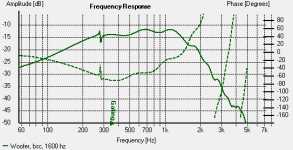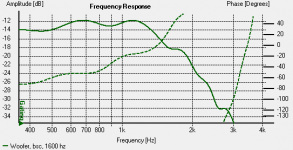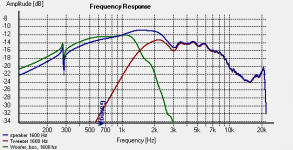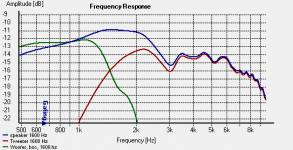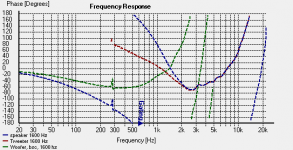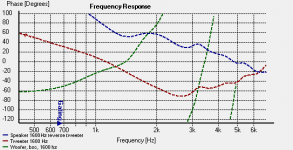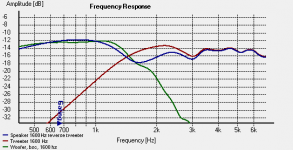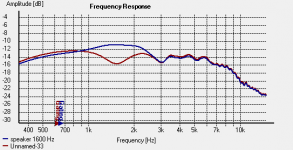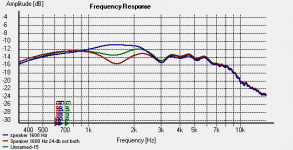Guesstimating, but if you LR4@1800 the breakup peak ought to be around -37 db. Might be enough to fix it for you.
From Zaph's measurements, I'd be comfortable running the DXT LR4 down to 1500 Hz, where distortion starts to climb and it naturally rolls off.
You only want a 16K 1st order roll off to flatten that peak out beyond audibility. I'd not mess with it until you get the rest taken care of.
From Zaph's measurements, I'd be comfortable running the DXT LR4 down to 1500 Hz, where distortion starts to climb and it naturally rolls off.
You only want a 16K 1st order roll off to flatten that peak out beyond audibility. I'd not mess with it until you get the rest taken care of.
Running the DXT down to 1500Hz with LR4?
wow, that sounds tough for a tweeter, but as you say, Zaph's measurements are there, so why not?
Guess I'll pull all the stops and go for 1600Hz x-over for the midwoofer then and see if I can stretch the DXT down to to meet it!
Yes, I'll definitively leave that HF peak issue allone untill I've worked on that new x-over frequency!
wow, that sounds tough for a tweeter, but as you say, Zaph's measurements are there, so why not?
Guess I'll pull all the stops and go for 1600Hz x-over for the midwoofer then and see if I can stretch the DXT down to to meet it!
Yes, I'll definitively leave that HF peak issue allone untill I've worked on that new x-over frequency!
I have run a 27TDFC down to 1600 using an ~8th order elliptical filter without issue. It doesn't have the benefit of the waveguide boosting its response at the bottom end (meaning that it doesn't work as hard for the same SPL).
Low order filters are an issue, but with at least LR4 I can get as loud as I want without noticeable stress. Not that I am a headbanger anymore.
Low order filters are an issue, but with at least LR4 I can get as loud as I want without noticeable stress. Not that I am a headbanger anymore.
Looking good. It would be beneficial to expand the vertical scale. Baffle width ~9"? That's the diffraction bump just before the roll off. Another reason to cross low - you don't need to mess with it. 
My filter is 4th order with a DEEP notch ~an octave away from the pass band. The initial roll off approximates LR8 to 60+ db down then bounces back up to ~-50 dB. Beyond the notch it is pretty close to LR4. Group delay is closer to 4th order than 8th. I got the idea from Jon Marsh over at HTGuide's DIY forum. He did it passively by adding a couple of parts to a 4th order filter.
My filter is 4th order with a DEEP notch ~an octave away from the pass band. The initial roll off approximates LR8 to 60+ db down then bounces back up to ~-50 dB. Beyond the notch it is pretty close to LR4. Group delay is closer to 4th order than 8th. I got the idea from Jon Marsh over at HTGuide's DIY forum. He did it passively by adding a couple of parts to a 4th order filter.
Sure,
Here's a new plot attached zooming in on the x-over area. I had less resolution on the last plot so that the extension of the break-up region would be visible.
Well, the baffle is 22 cm wide, so closer to 8 inches then. But yeah, good point about the difraction bump, looks like we got that under controll as a bonus!
Looks like the actuall -6dB point, as a function of woofer roll-off and filter slope, landed well on just over 1600Hz.
Now, the big question is what crossover to choose for the tweeter filter to get a combined response that matches best??
Looks like I have resistors to hit a 1700Hz tweeter x-over, is that worth a go?
Here's a new plot attached zooming in on the x-over area. I had less resolution on the last plot so that the extension of the break-up region would be visible.
Well, the baffle is 22 cm wide, so closer to 8 inches then. But yeah, good point about the difraction bump, looks like we got that under controll as a bonus!
Looks like the actuall -6dB point, as a function of woofer roll-off and filter slope, landed well on just over 1600Hz.
Now, the big question is what crossover to choose for the tweeter filter to get a combined response that matches best??
Looks like I have resistors to hit a 1700Hz tweeter x-over, is that worth a go?
Attachments
Yes. Since you have a natural roll off just below that, you might give second order electrical a try first. If that doesn't hit it, go third order. I'd be surprised if you need to go 4th order to match your woofer curve.
And don't worry about the tweeter. I forgot to mention a system with a T25C001 crossed at 1600 with just a cap and L-pad.
And don't worry about the tweeter. I forgot to mention a system with a T25C001 crossed at 1600 with just a cap and L-pad.
I was actually planning to use a fourth order filter as I allready have this configured on the card.
Allthough the tweeter has a natural LF roll-off, this is due to efficiency, not electrical reactivity, so I figure uasing a 4th order will make life easier for the tweeter.
Even if the tweeter can take it, it might allso be worth considering from a power compression point of view..
Having said that, is there any compelling reason I should NOT use 4th order??
I can't really see any, but then again, there might be complications I'm unaware of?
Allthough the tweeter has a natural LF roll-off, this is due to efficiency, not electrical reactivity, so I figure uasing a 4th order will make life easier for the tweeter.
Even if the tweeter can take it, it might allso be worth considering from a power compression point of view..
Having said that, is there any compelling reason I should NOT use 4th order??
I can't really see any, but then again, there might be complications I'm unaware of?
The compelling reason is that you'll probably end up with a 6th order acoustic response. At 2nd order electrical tweeter excursion will remain roughly constant below XO to the resonance so it won't put any mechanical strain on the motor. Power delivered will roll off with the filter.
4th order electrical on the tweeter may work out well with a notch cutting the woofer breakup. The notch will make the woofer roll off a little faster.
Just take your output from the first section to go second order. You don't need to touch the second high pass section. For third order, jumper the first cap and remove the R from output to the junction of the two cap spaces. The second CR gives you the extra order.
4th order electrical on the tweeter may work out well with a notch cutting the woofer breakup. The notch will make the woofer roll off a little faster.
Just take your output from the first section to go second order. You don't need to touch the second high pass section. For third order, jumper the first cap and remove the R from output to the junction of the two cap spaces. The second CR gives you the extra order.
That makes sense Bob,
From the woofer measurement, I have what to me seems like a fairly decent 4th order slope.
Looking at the SEAS and Zaph measurements of the DXT, it looks like there is a 2nd order roll of from about 1500Hz and adding a 2nd order electrical on top of thatshould yield close to a 4th order slope. But, are these measurements performed with some sort of filter to protect the tweeter? if so, the plots do not represent the true roll-off of the tweeter... I can't find any details on this ont the respective web-pages..
I can't find any details on this ont the respective web-pages..
I donæt know if it is possible to sucessfully match a 4th and 6th order slope, but matching two 4th order slopes seems a safe way to go!
And thanks for the tip on how to get a 12 dB /oct filter, quite self-evident really!
I'll try 2nd order at 1600-1700Hz and se how that goes!
From the woofer measurement, I have what to me seems like a fairly decent 4th order slope.
Looking at the SEAS and Zaph measurements of the DXT, it looks like there is a 2nd order roll of from about 1500Hz and adding a 2nd order electrical on top of thatshould yield close to a 4th order slope. But, are these measurements performed with some sort of filter to protect the tweeter? if so, the plots do not represent the true roll-off of the tweeter...
I donæt know if it is possible to sucessfully match a 4th and 6th order slope, but matching two 4th order slopes seems a safe way to go!
And thanks for the tip on how to get a 12 dB /oct filter, quite self-evident really!
I'll try 2nd order at 1600-1700Hz and se how that goes!
How big a cap do you have on your tweeter for protection? Either go big, or use it to get an odd order filter. Around 17.7 uf ought to give you a 1500 Hz rolloff. If you go with 50 uf you'll roll off <500 Hz, by then the tweeter ought to be far enough down that you don't hear the difference. The good news is either way you'll see it in the measurements.
So, more testing..and some more graphs with woofer, tweeter and combined response.
The first thing I notice is that summation gives a 1 dB hump at the x-over area. in it self not that much, but when bringing the tweeter level up, this will increase..
I see two options here, moving the x-over frequency of the tweeter up a bit, or changing from 2nd order to 3rd order filter slope..
I allso included a plot of the phase responses, not that I can make much out of it, but perhaps it gives an indication on how to best approach the summation hump??
Just listening to the speaker, the HF droop is of course obvious and the sound is a bit forward due to the 1-2 Khz lump. Apart from that, there are no immediately obvious issues..
The first thing I notice is that summation gives a 1 dB hump at the x-over area. in it self not that much, but when bringing the tweeter level up, this will increase..
I see two options here, moving the x-over frequency of the tweeter up a bit, or changing from 2nd order to 3rd order filter slope..
I allso included a plot of the phase responses, not that I can make much out of it, but perhaps it gives an indication on how to best approach the summation hump??
Just listening to the speaker, the HF droop is of course obvious and the sound is a bit forward due to the 1-2 Khz lump. Apart from that, there are no immediately obvious issues..
Attachments
How big a cap do you have on your tweeter for protection? Either go big, or use it to get an odd order filter. Around 17.7 uf ought to give you a 1500 Hz rolloff. If you go with 50 uf you'll roll off <500 Hz, by then the tweeter ought to be far enough down that you don't hear the difference. The good news is either way you'll see it in the measurements.
No cap for protection..
Here's the measurement with switched tweeter polarity.
No deep null or anything.. but rather having a 1-2kHz bump, there is now shallow droop around 1,5k..
What to make of this?
No deep null or anything.. but rather having a 1-2kHz bump, there is now shallow droop around 1,5k..
What to make of this?
Attachments
I decided to try 24 dB/oct on the tweeter, and that was not a bad idea..
Due to the steeper roll of, I got a slight dip around 1500Hz as opposed to the previous 1-2kHz bump.
Something like this was sort of expected due to the steeper slope.
Playing some music, this actually sounds noticeably better, a hint of "shrillness" seems to have disappeared.
As such, I could probably be happy to leave the x-over as it is.
If I am to try and remove this dip, I see two options; lowering the tweeter x-over slightly, or adjusting the Q of the filter a bit.
As I have trim-pots in place of the four resistors in the HP filter, I have good opportunity for tweaking a bit. Lets see what can be done..
Due to the steeper roll of, I got a slight dip around 1500Hz as opposed to the previous 1-2kHz bump.
Something like this was sort of expected due to the steeper slope.
Playing some music, this actually sounds noticeably better, a hint of "shrillness" seems to have disappeared.
As such, I could probably be happy to leave the x-over as it is.
If I am to try and remove this dip, I see two options; lowering the tweeter x-over slightly, or adjusting the Q of the filter a bit.
As I have trim-pots in place of the four resistors in the HP filter, I have good opportunity for tweaking a bit. Lets see what can be done..
Attachments
Changed the x-over frequency of the tweeter to 1450 Hz in order to try to fill out that dip.
The result can be seen on the green graph.
The dipp filled in nicely enough, but I allso got some gain at arround 2k.
this stil sounds better than the first attempt (blue), but some of that shrillness is creeping back.
So far, the red curve sounds best.
I think I will therefore leave the tweeter x-over at 1600Hz, and perhaps increase the woofer x-over a notch to see if that can fill out the dip without giving that gain at 2 Khz.
The result can be seen on the green graph.
The dipp filled in nicely enough, but I allso got some gain at arround 2k.
this stil sounds better than the first attempt (blue), but some of that shrillness is creeping back.
So far, the red curve sounds best.
I think I will therefore leave the tweeter x-over at 1600Hz, and perhaps increase the woofer x-over a notch to see if that can fill out the dip without giving that gain at 2 Khz.
Attachments
- Status
- This old topic is closed. If you want to reopen this topic, contact a moderator using the "Report Post" button.
- Home
- Source & Line
- Analog Line Level
- Shelving 2nd order high-pass?
